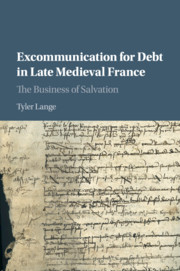Book contents
- Excommunication for Debt in Late Medieval France
- Excommunication for Debt in Late Medieval France
- Copyright page
- Contents
- Figures
- Tables
- Map
- Prefatory note
- Book part
- Note on names, dates, and currency
- Glossary
- Introduction
- 1 Church courts and credit
- 2 The supply of ecclesiastical justice
- 3 Case studies: demand for ecclesiastical justice
- 4 A crisis of credit? The Reformation and the early modern world
- Conclusion: from Church to market
- Select bibliography
- Index
- References
Select bibliography
Published online by Cambridge University Press: 05 March 2016
- Excommunication for Debt in Late Medieval France
- Excommunication for Debt in Late Medieval France
- Copyright page
- Contents
- Figures
- Tables
- Map
- Prefatory note
- Book part
- Note on names, dates, and currency
- Glossary
- Introduction
- 1 Church courts and credit
- 2 The supply of ecclesiastical justice
- 3 Case studies: demand for ecclesiastical justice
- 4 A crisis of credit? The Reformation and the early modern world
- Conclusion: from Church to market
- Select bibliography
- Index
- References
- Type
- Chapter
- Information
- Excommunication for Debt in Late Medieval FranceThe Business of Salvation, pp. 283 - 299Publisher: Cambridge University PressPrint publication year: 2016



